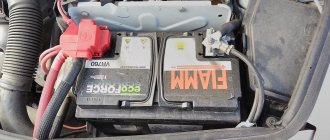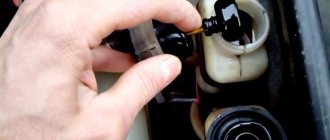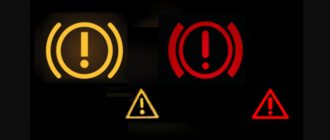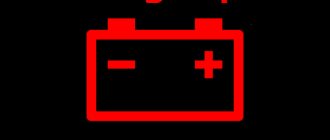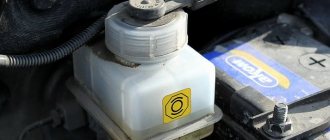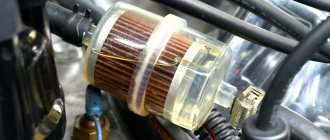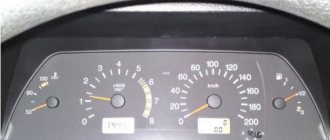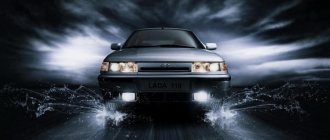Save article:
In this article:
- Why do you need a parking brake light?
- Why is the handbrake light on?
- What to do in this situation
- What to do if the parking brake light, on the contrary, does not light up
There is a special indicator on the dashboard, the so-called parking brake light. Often the indicator looks like an exclamation mark with arcuate lines on the sides. In addition, there may be the inscription “Brake”. If one or another type of symbol is active, you should stop and determine why the handbrake light is on.
How to check the parking brake cable
The parking brake light may illuminate, indicating a stretched cable.
It is important to determine the causes of this malfunction in order to avoid serious consequences on the road. Typically, the parking brake is diagnosed at a car service center on a special stand, but there are some ways to do it yourself
You don’t have to go to a car service center to stop the parking brake light coming on.
Typically, parking brake diagnostics are carried out at a car service center on a special stand, but there are some ways to do this yourself. You don’t have to go to a car service center to stop the parking brake light coming on.
Depending on the make of the car, the mounting location of the parking brake cables may vary slightly. However, the list of brake system components does not change.
The system looks similar in cars with parking brakes for the front wheels. The cables stretch during operation and need to be adjusted and lubricated.
It is recommended to check the cables every 6 months or when passing the next 10,000 km. If you suspect that the handbrake has become worse, contact a car service unscheduled, regardless of whether the light on the dashboard is on or not.
Cable wear is very serious. The cable may simply burst. In addition to the cable stretching, other parts of the system may rust and jam, which is why the parking brake does not perform its functions.
The handbrake is checked as follows: the car is positioned so that one of the rear wheels is suspended in the air. Then they activate the parking lever and try to spin the suspended wheel. If this succeeds, then the system is faulty. The cable needs to be tightened or completely replaced. In this case, the parking brake indicator remains illuminated.
There is another, more extreme method of checking the handbrake. This method may damage the brake pads and other elements of the system. Here's how this test is carried out: the car is put on the handbrake, the first gear is engaged, and then the gas is pressed to full. If everything is fine with the handbrake, the car will jerk a little and immediately stall.
Setting up the parking brake is almost identical for different car models. The handbrake can be adjusted in two ways, depending on the make of the car: from inside or under the car. For most cars, the second method is relevant, and we will dwell on it in more detail.
How to tighten the handbrake cable while under the car:
- Pull the handbrake up and lock it after 2 - 3 clicks (the exact number depends on the make of the car).
- Raise the car with a jack or initially place the car above the inspection hole, which is certainly more convenient.
- First loosen the tightening nut on the adjustment unit. If you now begin to rotate the other nut, the cable will tighten. Check the tension of the cable against the suspended wheel. If it can no longer be turned, the parking brake operates normally.
- Now release the handbrake and check if the wheel spins. If yes, then everything is correct.
- Check the handbrake again (put it on the handbrake, spin the wheel and remove it from the handbrake). It is better to carry out such a verification test several times.
Last step: tighten the locknut. The parking brake can now be used. The indicator will stop lighting after this problem is resolved.
ABS turns on randomly, the light blinks or lights up periodically
One of the most difficult forms of breakdowns is the constant blinking of the ABS light bulb. This means that the anti-lock braking system sensors send incorrect signals to the computer, which, in turn, issues other incorrect commands to the vehicle's systems and modules. In such cases, many people prefer to simply turn off the anti-lock system, since unpleasant incidents may occur. For example, turning on ABS at a speed of 90 kilometers per hour with light braking can damage the chassis of the car and contribute to a complete loss of control over control. It's better to do this:
- bring the car to a service center for diagnostics, find out the reason for the chaotic operation of the equipment;
- for domestic cars equipped with a primitive anti-blocking device, it is better to immediately disable the system;
- complex designs and on-board electronic systems of foreign cars will have to be reflashed for repair;
- on some machines it will be easier to find the problem and fix it than to disable the anti-lock;
- you need to keep in mind that this particular system is not always the cause of the ABS light coming on; the problems can be different;
- During the diagnostic process, it is better to check the entire on-board electrical system and equipment.
By paying a certain amount for a car inspection, you can get the right answers to important questions. Sometimes a light that comes on on the panel can develop into a full-fledged repair of important units and components of the car, so you will have to spend a lot. But in most cases, this problem is not so expensive to solve. The cost of repair work depends, of course, on the make and model of the car, and on the price of spare parts. If an ABS sensor for a domestic car costs from 600 rubles, then a Japanese SUV will cost more than 10,000 rubles to replace one such sensor. We suggest watching a video about solving a similar problem using computer diagnostics:
What to do if the handbrake light does not light up
You need to check the operation of the handbrake if the indicator does not light up. Suspected faults:
- the element has failed;
- there was a break in the wires;
- There is no “ ” on the light bulb.
There may be a fault in the alternator wiring. The wires that go to it are red and brown. Turn the ignition on and short the brown wire to any metal part. The battery indicator should light up together with the brake system lever (duplication occurs at start and lights up through the diode). The battery indicator is on, but the brake lever light is not on, which means the diode is damaged.
Recommendations from experienced drivers:
- Inspect the limit switch and its connector.
- Focusing on the end of the handle, find the hidden stopper, push it and pull it.
- Inspect the fuses.
- Inspect the fastener: is it securely attached to the plate and are there various foreign objects present?
- Use the car drive and move the handle up/down.
- Lightly hit the console. Sometimes it can give a positive result if the contact is simply not very good.
Often, a malfunction can occur due to the traction spring of the lever pawl, which is located inside. The problematic element should be changed. However, it is not always possible to do this. Simply remove and stretch the spring.
Let's consider the sequence of actions for removing the latch and repairing it using the example of a VAZ car:
- remove the button by unscrewing it counterclockwise;
- remove the spring from the rod rod;
- try to stretch it by three centimeters;
- reverse steps to put everything in place.
Do not forget to read the instructions for the machine before performing any actions, this will definitely be beneficial.
Repair
Often the problem is related to the lever pawl traction spring (it is located inside). The worn part must be replaced. If this cannot be done immediately, remove and stretch it.
Algorithm for dismantling the retainer and repairing it using the example of VAZ cars:
- remove the button (unscrew it counterclockwise);
- remove the spring from the rod rod;
- stretch it 3 cm;
- install everything back.
We remind you that it is always useful to refer to the car’s instructions before any manipulations, for example, removing the central tunnel.
The car's dashboard contains sensors and warning lights that monitor the operation of the car's engine and a number of other systems responsible for traffic safety. This includes the brake system warning light. When the ignition is turned on, this lamp lights up, but after the engine starts, it goes out, which indicates the normal state of the braking system.
But drivers face this problem when the brake warning light comes on while driving. Moreover, it can light up constantly, flashing (haphazardly), only when the brake pedal is depressed. And this may already partially indicate where to look for the reason for this behavior of the signal lamp.
Why is the brake light on?
But let's start with the design features of the brake system alarm. Previously, cars used only one sensor - the level of brake fluid in the system, which sent a signal to the warning lamp. Since fluid is the main working element of the system, and its leakage leads to the brakes stopping working, naturally, the designers installed a sensor to monitor the level.
Additionally, the car also has a parking brake, the use of which must be monitored by the driver. On some models, the warning lamps for the working and parking systems are separated. The warning light with an exclamation mark in a circle is responsible for the fluid level, and the indicator marked with the letter “P” signals that the handbrake is engaged, and it turns off after the car is released from the handbrake.
But often a car has only one warning light, to which both the liquid level sensor and the handbrake sensor are “attached”.
Modern cars use circuits that additionally include brake pad wear sensors and brake light lamps. Failure of these elements causes the lamp on the dashboard to light up.
There are other design nuances that cause the indicator to glow. On VAZ models of the 10th family of the first years of production, a starter protection relay was included in the circuit, which forcibly turned it off after starting the engine. In this circuit, the designers connected the power supply circuit for the brake system lamp to this relay.
Why does the brake warning light on the dashboard come on or does not go out after starting the engine? If this happens while moving, it is better to stop moving and carry out diagnostics. If the light does not go out after starting the engine, it is better not to drive until the problem is resolved.
Possible fines
Motorists are naturally afraid of fines for not using the handbrake on their car. And a traffic police officer can bring administrative liability for this.
The Code of Administrative Offenses actually has Article 12.5. Only here some cunning traffic police officers rely on the second part of this article, which prescribes the punishment for driving a vehicle with a faulty brake system. This threatens with a fine of 500 rubles and detention of the car.
In fact, this article is about the handbrake. Only the document clearly states that the parking brake is an exception. That is, according to 12.5 Part 2, you can only be punished for a malfunction of the brake system, but not for problems with the handbrake.
The first part of Article 12.5 of the Code of Administrative Offenses is relevant. Here we are talking about the same 500 ruble fine
But it is important that the employee has no right to detain the vehicle
If you have been issued a fine, then you have the opportunity to pay not 500, but 250 rubles. This penalty is included in the list of items that are eligible for a 50% discount if paid within 20 days after the ruling is issued. Just wait until your receipt appears in the traffic police database.
Sources
- https://cartore.ru/85-regulirovka-stoyanochnogo-ruchnogo-tormoza-svoimi-rukami.html
- https://autostuk.ru/tros-ruchnogo-tormoza-zamena-regulirovka.html
- https://uremont.com/publications/articles/regulirovka-trosov-stoyanochnogo-tormoza-central-nym-natyazheniem
- https://marshal.ru/articles/prichiny-po-kotorym-ploho-rabotaet-ruchnoy-tormoz-v-avtomobile
- https://okeydrive.ru/kak-podtyanut-ruchnik/
- https://motorltd.ru/kak-podtyanut-ruchnik-svoimi-silami/
- https://neauto.ru/pochemu-na-avtomobile-ne-derzhit-ruchnik-i-chto-delat-v-takoj-situacii/
Checking the mechanical component
Self-diagnosis is a simple operation. It is divided into two components - mechanical and electrical. The first is very important, since it evaluates the condition of the brake system drive and determines its performance.
Checking the mechanical component is reduced to assessing the level of brake fluid in the reservoir and the condition of the drive lines and system components - the master brake cylinder and operating mechanisms.
The brake reservoir is located in the engine compartment, on the right near the rear panel of the engine compartment. It is not difficult to find it, since there are two wires going to the tank cap.
When checking, disconnect the wires and unscrew the cap to determine the brake fluid level. There are marks on the walls of the tank, by which you can understand how much liquid is left. A level above the middle between the marks is considered normal.
For an additional check, we start the car and press the brake pedal a couple of times, after which we roll the car back and inspect the surface of the ground for traces of leaking fluid, and check the fluid level. If it is detected, the brake line is damaged, and the amount of fluid will decrease.
If there is a brake fluid leak, the car cannot be used because the car does not have brakes. The best option in this case is to call a tow truck to deliver the car to the repair site. But if you have enough driving experience, then we get to the service station or garage on our own. Car brake systems usually have two circuits, and if the line of one of them is broken, the second continues to work.
Sometimes there is a problem with the warning light coming on when you press the brake pedal. The reason for this lies in two factors - low fluid level in the reservoir and worn disc brake pads. When braking, fluid flows into the working cylinders and the amount in the tank drops below a critical level, which is why the lamp lights up. This can be treated by installing new pads and adding fluid to the reservoir.
Why do you need a hydraulic handbrake?
The argument about stretching the cable of a mechanical handbrake is a strong argument, but not the only one or even the main one. This tuning is preferred by lovers of sports driving, since the hydraulic parking brake allows you to brake the rear wheels, and with unequal effectiveness. Under normal conditions, such actions are possible only with remarkable driving skills, and even then not on all cars. Note that with such a radical modification of the car’s brake system, the regulator must be installed between the main brake cylinder and the hydraulic handbrake - only in this case will you be able to redistribute the braking force, which is accentuated on the rear axle shaft, over a fairly large range, while the power of the front brakes will also increase. But remember that, according to the rules for operating vehicles, unauthorized intervention to change the standard design of the brake system is unacceptable if this is not approved by the car manufacturer.
Warning icons on the panel
The steering wheel icon can light up in two colors. If the yellow steering wheel is on, then adaptation is required, and when a red image of the steering wheel with an exclamation mark appears, you should already be concerned about the failure of the power steering or power steering system. When the red steering wheel lights up, your steering wheel will probably become very difficult to turn.
The immobilizer icon usually blinks if the car is locked; in this case, the indicator of a red car with a white key signals the operation of the anti-theft system. But there are 3 main reasons if the immo light is constantly on: the immobilizer is not activated, if the tag on the key is not read or the anti-theft system is faulty.
The handbrake icon lights up not only when the handbrake lever is activated (raised), but also in cases where the brake pads are worn out or the brake fluid needs to be topped up/replaced. On a car with an electronic handbrake, the parking brake light may come on due to a glitch in the limit switch or sensor.
The coolant icon has several options and depending on which one is lit, draw conclusions about the problem accordingly. One red lamp with a thermometer scale indicates an increased temperature in the engine cooling system, but a yellow expansion tank with waves indicates a low coolant level in the system. But it is worth considering that the coolant lamp does not always light up at a low level; perhaps there is simply a glitch in the sensor or float in the expansion tank.
The washer icon indicates a low fluid level in the windshield washer reservoir. Such an indicator lights up not only when the level actually decreases, but also if the level sensor is clogged (the sensor contacts become coated due to poor-quality liquid), giving a false signal. On some vehicles, the level sensor is triggered when the washer fluid does not meet specifications.
The ASR icon is an Anti-Spin Regulation indicator. The electronic unit of this system works in tandem with ABS sensors. When such a light is constantly on, it means the ASR is not working. On different cars, such an icon may look different, but often in the form of an exclamation mark in a triangle with an arrow around it or the inscription itself, or in the form of a car on a slippery road.
Catalyst icon
It often lights up when the catalytic element overheats and is quite often accompanied by a sharp drop in engine power. Such overheating can occur not only due to poor cell throughput, but also if problems arise in the ignition system. When the catalyst fails, high fuel consumption will be added to the burning light.
The exhaust gases icon, according to information from the manual, indicates a malfunction in the exhaust gas purification system, but, as a rule, such a light starts to light after poor refueling or the presence of an error in the lambda probe sensor. The system registers misfires of the mixture, as a result of which the content of harmful substances in the exhaust gases increases and, as a result, the “exhaust gases” light comes on on the dashboard. The problem is not critical, but diagnostics are worth doing to find out the cause.
Reporting a malfunction
The battery icon lights up if the voltage in the on-board network drops; often this problem is associated with a lack of battery charge from the generator, so it can also be called the “alternator icon”. On vehicles with a hybrid engine, this indicator is supplemented by the inscription “MAIN” at the bottom.
The oil icon , also known as a red oil can, indicates a drop in the oil level in the car engine. This icon lights up when you start the engine, and does not go out after a few seconds or may light up while driving. This fact indicates problems in the lubrication system or a drop in oil level or pressure. The oil icon on the panel may have a droplet or waves at the bottom; on some cars the indicator is supplemented with the inscription min, senso, oil level (yellow inscriptions) or simply the letters L and H (characterizing low and high oil levels).
The airbag icon can light up in several ways: either the red inscription SRS and AIRBAG, or “a red man wearing a seat belt,” with a circle in front of him. When one of these airbag icons lights up on the panel, the on-board computer notifies you of a malfunction in the passive safety system, and in the event of an accident, the airbags will not deploy. Read the article on the website for the reasons why the airbag sign lights up and how to fix the problem.
The exclamation mark icon may look different and its meaning will accordingly be different. So, for example, when the red (!) light is on in the circle, this indicates a malfunction of the brake system and it is advisable not to continue driving until the cause of its occurrence is determined. They can be very different: the handbrake is up, the brake pads are worn out, or the brake fluid level has dropped. A low level is precisely what poses a danger, because the reason may not only be in heavily worn pads, as a result of which, when you press the pedal, the fluid disperses throughout the system, and the float gives a signal about a low level, the brake hose may be damaged somewhere, and this is much more serious. Although, very often the exclamation mark lights up if the float (level sensor) is faulty or shorted, and then it simply lies. On some cars, the exclamation mark is accompanied by the words “BRAKE”, but this does not change the essence of the problem.
An exclamation mark can also light up in the form of an “attention” sign, both on a red and yellow background. When the yellow “attention” sign lights up, it informs about a malfunction in the electronic stabilization system, and if it is on a red background, it simply warns the driver about something, and, as a rule, explanatory text is displayed on the dashboard display or combined with other informative text designation.
Why does the indicator ((!)) appear?
The brake system consists of a mechanical part (discs, pads, brake fluid, lines, etc., manual or electric parking brake) and an electronic part - a set of sensors and wiring.
Only on certain car models, signals from different sensors are indicated by the lighting of individual lamps, and then the letter ((P)) on the dashboard indicates that the handbrake is engaged, and the icon ((!)) indicates a malfunction of the main brake system.
Often, cars have only one warning lamp, which receives signals from the brake fluid level sensor, pad wear, brake light and handbrake.
Normally, the “Brake” or ((!)) indicator lights up before starting the engine, when the key is in the “On” position, and goes out immediately after the engine starts. And it appears on the dashboard subsequently only if the owner puts the Renault on the parking brake.
When to use a parking mechanism and when not to
A handbrake is a kind of alternative to the main brake system and its parts. If the latter fails, the handbrake will help to brake. There are often situations where the parking brake is applied in the event of a short-term deceleration of the machine. This may be necessary if you need to quickly go to a kiosk or store, leaving the car near the side of the road, then you must definitely use the handbrake.
The handbrake can also be useful to prevent the car from rolling while driving.
An example of such a situation is a stop where there is a closed crossing. In order to drive further you will need a handbrake. People with many years of driving experience can use the handbrake when performing maneuvers, this could be a sharp turn or driving in a confined space.
To ensure trouble-free operation of the handbrake, we do not advise car owners to use this system when parking the car for a long time. Especially if you know for sure that you won’t go anywhere for a week or two, then you don’t need to turn on the lock, otherwise the pads will “stick” to the drums. You also need to be careful when using the parking mechanism during periods of persistent frost. Excessive humidity from a car wash can cause the brake pads to freeze and immobilize the car. The condition of the parking mechanism must be checked periodically, because if the main brakes fail, the handbrake will remain the only salvation.
Clarifying the reasons for the handbrake light on the dashboard to come on. Tips for car repair.
On the dashboard of your car there is an information panel, as well as a pool of light bulbs. Some of them are alarming error lights, the signal of which means that something is faulty in the car. And therefore, this is a signal to contact a professional car service, where your car will be provided with specialized diagnostic services (and in this case, computer diagnostics of the car is needed) and repairs.
One of the warning lights - a signal of error and malfunction - is the handbrake light. We will tell you about it in more detail, and also emphasize why the handbrake light on the dashboard may be constantly on.
What to do if the parking brake light is on
You can understand what’s going on and why this indicator lights up like that on your own if you have sufficient knowledge and everything you need. To carry out diagnostics, you need to inspect the car from below, that is, use a pit or a lift.
So, once under the car, we proceed as follows:
- we check the handbrake operating system: raise and lower the lever, checking whether the indicator lights up;
- Let's see how much brake fluid is left. Remember that the car must be level for your inspection to be objective;
- If the problem is still not solved, you need to get a special float sensor. Sometimes it needs cleaning to work correctly;
- pull the parking brake cable and check if it is stretched;
- inspect the brake pads. If you see that they have worn out by more than 80%, this is a reason to urgently replace them. With this degree of abrasion, the indicator lights up even with the handbrake fully lowered.
Below we will go into more detail about the procedures for diagnosing these faults. If your actions have no result and the system light is still on, be sure to contact a car service center. The problem may be more critical than it seems at first glance.
Troubleshooting the BMW parking brake
First try performing a soft reset on your BMW parking brake. Press and hold the parking pedal. Turn on the ignition. Press and hold the end button (P) for 5 seconds. If this does not work, reset the parking brake module using one of the following methods.
Remove the parking brake fuse
Remove the parking brake safety for at least 5 minutes. The parking brake fuse is located in the fuse box in the trunk.
It will be marked P on your fuse chart and could be fuse #10, 94, 129.
Alternatively, you can disconnect the negative terminal of the battery for at least 15 minutes.
If you disconnect the battery, you do not need to register the battery, but you may need to reset your comfort memory settings such as radio presets, seat memory positions, etc.
Parking brake drive
The parking brake actuator can fail and is one of the most common failures. The mechanism inside the parking brake actuator that turns the parking brake on and off may break.
To solve this problem, you have two options.
Option 1
You can ask your dealer or auto mechanic to fix your BMW parking brake problem. At the BMW dealer, repairing the electronic parking brake actuator costs over $1,000.
Option 2
Keep reading to find out what you need and the steps needed to complete this repair yourself.
What you will need
BMW Parking Brake Actuator Repair Kit - Upgrade with metal gear and shaft. Plastic gear repair kits are available, but they are less durable and more difficult to install.
Before you start
- Disconnect the battery - the battery will be located in the trunk.
- Do not apply the parking brake if the BMW parking brake actuator module has been removed for repair.
Instructions
- Remove the parking brake actuator from the trunk.
- Open the parking brake housing and replace the broken gear. Use a metal mechanism that includes a shaft. If you buy a kit that only has a plastic mechanism, you will need to use the old shaft. The procedure is a little more complicated and requires a press. See these instructions if you are installing a plastic mechanism.
- Install the parking brake actuator and use a BMW scan tool to reset BMW parking brake fault codes.
Does glycol brake fluid burn?
The brake systems of the vast majority of cars are filled with glycol brake fluid of the DOT-3, DOT-4 or DOT 5.1 brand. These formulations consist of more than 90% glycols and polyglycols. The rest of the total volume is occupied by additives that improve the performance of brake fluid.
Glycols are dihydric alcohols. Like all alcohol group liquids, glycols have most of their properties. Including the ability to maintain arbitrary combustion after ignition, without the supply of thermal energy from the outside. This means that the brake fluid, once ignited, will burn until it burns out completely. At the same time, there is no need to heat it to maintain combustion.
The ignition temperature of brake fluid varies in each individual case. It varies depending on the specific brand of brake fluid. However, an ordinary open flame of any nature (from a match, a gas torch or burning hydrocarbon fuel) is sufficient to begin the combustion process of glycol brake fluid.
Brake fluid does not ignite immediately after contact with an open flame. That is, this liquid does not belong to the category of flammable. She's just flammable.
The combustion product of brake fluid is volatile hydrocarbon oxides, carbon dioxide and carbon monoxide, as well as water vapor. There are few sediments of the solid fraction remaining, and they are mainly products of decomposition of additives.
Checking the brake fluid level
It would seem what hydraulics can have to do with the indicator of the handbrake indicator. However, one of the most common reasons for the constant glow of the light is precisely that there is not enough brake fluid in the hydraulic, that is, working system.
In order to check its level, you should do the following:
- The machine must be parked on a level surface. When the engine is cold, open the hood.
- We are looking for the hydraulic brake master cylinder. It is located in the rear of the engine compartment on the driver's side. We need a plastic white reservoir located above the cylinder. Cars manufactured before 1980 may have a metal cylinder. In this case, you will have to remove its cover to check the fluid level.
- Most reservoirs have marks indicating the minimum and maximum fluid levels. If it is approximately in the middle of these marks, then there is enough liquid.
- If necessary, liquid should be added to the tank. This must be done very carefully, as the substance is toxic and can cause corrosion of metal surfaces.
- Close the reservoir with a lid and lower the hood.
If the fluid level in the reservoir was significantly below the minimum mark, you should check the brake pads to see if they are worn out. Then the fluid will flow out of the pipes and flow to the brake calipers. As a result, fluid will quickly leak out of the system, and its level will not be enough for the normal functioning of the hydraulic system. This is one of the reasons why the handbrake light may be constantly on.
It should be noted that not on all car models the handbrake light comes on when driving if the brake pads are worn out.
Sometimes it happens that there is enough fluid in the reservoir, but the brake pedal still sticks. As a result, the handbrake light is constantly on, because the fluid does not reach the master cylinder. If you notice this problem, you should immediately take the car to a car service center, as significant damage may occur in the brake system.
basic information
The main function of braking is to control the speed of the car, stop it, and also hold it in one position using the braking force between the road and the wheels of the car. The braking force can be generated by a car engine, a car wheel braking mechanism, or an electronic or hydraulic retardant brake located in the transmission. To enable all of the above functions, various types of braking systems are installed on the vehicle.
Consequently, the question arises, how much and in total?
- Working. This type is used at any speed of the machine to completely stop or reduce speed. Moreover, it begins to function immediately after pressing the brake pedal. It is considered the most effective compared to other types.
- Spare. Used when the main braking unit is faulty. This type of brake unit can be of two types, autonomous or its functions are performed as part of the working braking system.
- Parking lot. It is necessary to keep the machine in place for a certain time. That is, thanks to it, the possibility of the car moving without the driver’s knowledge is completely eliminated.
- Additional. Used on vehicles that have increased weight to stop on slopes. Quite often it happens that its stopping functions are performed by a motor on which the pipeline is closed using a damper.
What is the operating principle?
Let's look at the principle of braking using the example of a hydraulic operating unit. When the brake is pressed, the load is transferred to the amplifier, which creates additional reinforcement on the main cylinder. The piston of the main brake cylinder collects all the fluid in the car wheel cylinders using pipelines. Moreover, at the same moment, the fluid pressure in the brake drive increases. Thanks to the pistons of the car wheel cylinders, the brake pads move to the discs, or as they are also called drums.
After pressing the brake, the fluid pressure increases, as a result of which the braking mechanisms are activated, causing the rotation of the car wheels to slow down and generate braking force at the point of contact of the car tires with the road surface. Moreover, the more force is applied to the brake pedal, the more efficiently and quickly the car wheels will brake. The liquid pressure at the moment of stopping can reach from ten to fifteen megapascals.
Parts of the springs are retracted from the drums using blocks. Brake fluid passes into the main braking cylinder from the car wheel cylinders thanks to pipelines. Thus, the pressure of the braking system decreases. Braking performance is greatly enhanced by the use of vehicle safety systems.
Basic faults
The main task of diagnostics is to detect malfunctions in the brake system, as well as eliminate them with minimal use of money. In addition, timely detection of braking faults will allow you to avoid large expenses, because you can prevent breakdowns. In specialized centers, brake system diagnostics are carried out on a special stand, but you can do it yourself at home. To identify faults, you need to pay close attention to your vehicle.
https://youtube.com/watch?v=Av-jj8NNrv8
So how many brake system faults are there?
- The occurrence of extraneous noise;
- A creaking noise is heard when the vehicle is braking;
- There is noticeable leakage of brake fluid;
- The brake pedal gets stuck;
- The braking distance has increased noticeably.
As a rule, all of the above breakdowns of the braking system are associated with the following reasons:
- The tightness has broken;
- Low fluid level;
- Irregular fluid changes;
- The brake pads are badly worn.
Most often, the cause of problems is untimely replacement of the fluid, and this can lead to complete brake failure. It needs to be washed regularly due to the fact that at the time of use it absorbs all the moisture. There may also be an insufficient level of fluid in the braking system, as it evaporates during boiling, which occurs when the vehicle is braking.
What to do if the lamp ((!)) lights up while moving
Be prepared for the worst - brake failure. Turn on the emergency lights and carefully check whether the brakes respond to pedal pressure.
If the pedal fails, try to “bleed” the system with a few strong presses.
Look for a place to stop, slow down using engine braking or applying the parking brake.
After stopping, check the brake fluid level. Further options are possible.
If the DOT level is OK, check the condition of the handbrake and the condition of the brake lights:
- Find the handbrake sensor (in a situation with an electric parking brake - right under the button), put the car on the handbrake and press the sensor rod. If the brake system indicator goes out when pressed, the reason is a faulty sensor.
- ask your assistant to depress the pedal (or press it down with improvised means) and inspect the lights yourself.
If the brake fluid level is low, it must be topped up. Choose brake fluid of the DOT-4 standard or better - recommended by the manufacturer, that is, for Renault - ELF.
Downstream oxygen sensor
In addition to the previous reason, one can also include the oxygen sensor located at the bottom of the car next to the catalyst. It is designed to capture unused oxygen to determine if the mixture is fed rich or lean. It is thanks to him that most of the work is done to adjust the composition of the fuel-air mixture.
The sensor operates under the most difficult conditions: high temperature, low-quality fuel, impurities, and its contact group comes into contact with dust, dirt and moisture. That is why it can give errors or fail completely, which leads to the “check” signal.
What to do if the parking brake light is constantly on
Each car enthusiast can determine problems with the brake mechanism himself. You just need to find an inspection hole, overpass or lift, then the help of auto repair shop mechanics will not be needed. However, if you are not confident in your abilities, it is better to turn to specialists.
Let's carry out some manipulations to find out why the handbrake light is on, even if it is lowered. You should:
- Repeatedly lower/raise the brake lever and see how the light reacts - this will determine whether the handbrake is working or not.
- Place the car on a flat surface and check the brake fluid volume.
- Add brake fluid if there is not enough of it, and check the operation of the handbrake light again.
- If no changes occur, remove the float sensor from the tank, clean it, and tap it to rule out problems with the float.
- Inspect the brake pads. If the wear is 80% or more, the indicator will light even when the lever is lowered. It is necessary to replace the pads with new ones.
After completing the suggested actions, is the handbrake light still on? This means that you have a direct route to a car repair shop, because it is better to entrust the diagnosis of the brake system to professionals.
The procedure for carrying out adjustment work
Checking the condition of the hand brake system must be carried out strictly in the presence of an inspection pit, lift, or overpass. In the absence of such conditions, it is necessary to raise the rear wheel (or rather, both, i.e. the entire part of the body), and also install “goats” for support. In some vehicle models, regulation is carried out in the cabin. Therefore, before starting work, it is necessary to get an answer to the question of what exactly the handbrake system is.
Let's consider the procedure for carrying out work for most common brands and models of vehicles - Renault Logan, Nover N5, Kia Sportage 3.2, etc.
- The first thing to do is lift the handbrake lever. This needs to be done in a couple of clicks.
- Next you need to loosen the nut in the equalizer area.
- Wrap it to tension the cable element. If this does not happen, the unit needs to be replaced.
- Check the tension level. To do this, the handle is tightened the required number of clicks.
- If everything works properly, it will take a lot of effort to turn the rear wheel over by hand.
- Next, you need to release the lever element and ensure that the rear wheels turn. It is necessary that they begin to rotate without jerking. Check the condition of each pad.
- Next, you need to lower the car and check the functioning of the handbrake in first gear.
If you require work on a brake element, in particular the handbrake, contact our organization. We will replace and repair the pads, lock nut, and entire brake if necessary.
What does the brake system say - indication and its meaning
First of all, this material is not a reprint of car instructions, but our generalized experience. We deliberately omit the situation when the error indicator appears for a few seconds when starting the car and goes out after 3-5 seconds: this is a consequence of self-diagnosis and, accordingly, is normal. A cause for concern is when errors appear on the device for a longer period of time. Since the error icon does not always indicate a direct problem, we will try to include non-critical reasons in the description. And, of course, the nature of the indicators may change from model to model, so our review is general in nature.
First of all, the color of the indicator. Yellow, as a rule, has an informative and warning character, which means you need to start looking for a problem as soon as possible. Red - the problem requires immediate diagnosis and elimination, operation of the car is highly not recommended.
The most basic indicator of an error related to the brake system. The main reasons for the indication include:
- hand brake on
- low brake fluid level
- malfunction of ABS sensors
— wear of the brake pads/rupture of the wear sensor target
— the brake light does not function
Secondary reasons. Most often, the circuit breaks – starting from the terminals of the ABS unit. Another reason is the alarm: incorrect installation or a dead battery in the tag.
Elimination. Start small - make sure the handbrake is released and turned off. Check the brake fluid level in the reservoir and top up if necessary. All other diagnostic methods will have to be delegated to a service station: checking the condition of brake pads, electronic wear sensors, diagnosing ABS systems and other circuits.
— A type of indicator (!). It is found on cars where, in addition to the classic exclamation mark, there are clarifying symbols that more accurately indicate a malfunction. Most often, this is a direct indication of wear on the brake pads (the icon itself indicates whether the car is front or rear axle). However, before rushing to buy a new kit, it is better to diagnose the problem. In particular, such an indicator may flash if the wear sensor breaks.
— Variation for cars with electronic handbrake. Such an icon in some cars is simply not provided as standard, where the role of the indicator is played by the above symbol (!). The error indicates a malfunction of the parking brake - mechanical or electronic. And, of course, the normal activation of the handbrake.
Elimination. If such an indicator does not go out after the car is released from the parking brake, and the movement of the car is essentially blocked, an emergency shutdown option is provided. As a rule, it is enough to pull the drive cable hidden in the passenger compartment or trunk of the car. If you succeed in doing this, go straight to the service center, diagnose and repair the function: a problem with the cable, control unit or parking brake system device.
- Most often, it indicates a problem with the electronics, and not with the brake system itself. Simply put, if one ABS light is on, then your car will brake quite normally, but stabilization systems are unlikely to help you in emergency situations. What does the indicator say? Minimum – broken wiring in the ABS circuit, maximum – electronic system control unit.
Secondary reasons:
— in snowy winter, good slipping can cause an ABS error. After driving onto hard surfaces the error will disappear
— dirt falling on the ABS sensors distorts their readings. After a good wash the indicator will go out.
— the indicator may also light up immediately after a visit to the service station (engaging in gear with the car hanging on a lift). After the first 50-100 meters of vehicle movement, the error will go out.
Troubleshooting: in-depth diagnosis and treatment of the problem based on the diagnosis obtained.
A combination of indicators is also possible. For example, the combination of (!) and (ABS) icons indicates a problem in the braking system, which is caused by a malfunction of the anti-lock braking system.
Basic brake system terms - what do you need to know?
Video “checking abs sensors”
Checking ABS sensors is demonstrated in a video provided by the “1000 DIYs and Tips” channel.
The ABS system, which is installed on almost all modern cars, like other complex parts and components, is susceptible to various malfunctions. The standard ABS operates constantly, being activated when the ignition key is turned, and the information collected by the anti-lock braking system is used by other systems, for example, ESP.
Despite the fact that ABS self-diagnosis is performed regularly, you have to fix any problems yourself, since malfunctions in the system are not so rare. If the ABS indicator is constantly on or flashes periodically while driving, this is a reason to check the functionality of the system, which can be done either independently or by contacting a service center.
How to define the problem more accurately
If the indicator lights up during hard braking, this is an argument in favor of the version with worn pads. The solution is to replace the pads.
If the light periodically goes out, this may be due to the fact that the liquid splashes in the tank during driver maneuvers, and at some moments its level is below the diagnostic float. The solution is to check the tank and add DOT to the level.
If the ABS lamp lights up along with the indicator ((!)), this indicates that the ABS sensor has failed.
On Renault models with an electronic handbrake, the “Brake” lamp may come on due to a faulty parking brake sensor.
Frequent causes of breakdowns
As a rule, the answer to the question of why the handbrake does not work lies in the most banal things. There are 4 main parking brake faults.
- An incorrectly adjusted bolt that needs to be loosened or tightened.
- Braided cable wedge. In this case, the handbrake breaks down due to moisture getting inside, which leads to corrosion.
- Broken cables running from the bar to the wheels. This element is easy to replace.
- Cable souring. This happens if you do not use the parking brake for a long time.
In addition, the reason why the handbrake breaks sometimes lies in the condition of the brake pads. They can wear out, which is why a characteristic grinding noise is heard when the car stops. In this case, it is necessary to replace worn parts, which, as a rule, fail on the right and left wheels at the same time. Incorrect use of the handbrake itself can also lead to this. It must be completely lowered while driving.
Another reason why the handbrake does not work well is the appearance of deposits on the brake pads. This happens rarely, most often after driving around puddles. Ice, salts and chemicals can be removed by lightly pressing the brakes while driving the vehicle for short distances. In addition, the linings may simply be oily due to a leak in the oil seal or working cylinder. In this case, you must first eliminate the fault in the leaking element, and then completely replace the pads or clean them.

